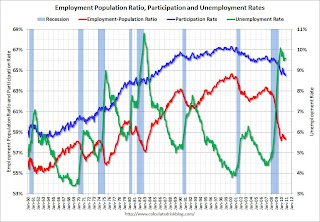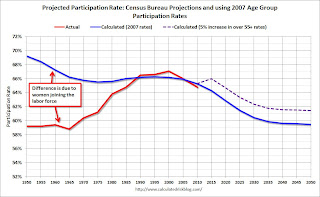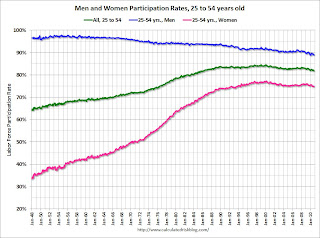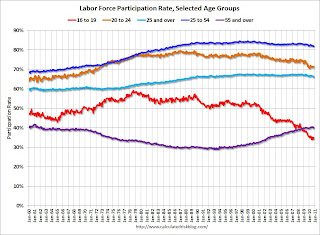by Calculated Risk on 11/11/2010 08:20:00 PM
Thursday, November 11, 2010
Report: Discussions underway to assess readiness to activate EFSF for Ireland
Please don't miss my earlier post: Labor Force Participation Rate: What will happen?
From the Irish Times: Merkel refuses to back down over debt burden
The Irish Times has established ... that informal contacts are under way between Brussels, Berlin and other capitals to assess their readiness to activate the €750 billion rescue fund in the event of an application from Dublin.Note: The European Financial Stability Facility (EFSF) is complicated and currently unfunded.
Also from the Irish Times (I noted the bank funding issue this morning based on information from a contact in Europe): Investor concern hits Irish banks as funding costs soar
INVESTOR CONCERN switched to the Irish banks yesterday as the cost of funding for AIB and Bank of Ireland rose to record levels and the credit-default swaps on Irish banks soared.And from the Irish Times: G20 concern over Irish debt as bond yields pass 9%
Last night the rating agency Moody’s said it was awaiting the release of Ireland’s four-year fiscal plan later this month to decide whether to downgrade the country’s credit rating.
Hotels: RevPAR up 8.2% compared to same week in 2009
by Calculated Risk on 11/11/2010 06:15:00 PM
Hotel occupancy is one of several industry specific indicators I follow ...
Important: Even though the occupancy rate is close to the weak 2008 levels, and RevPAR (revenue per available room) is up 8.2% compared to the same week in 2009 - RevPAR is still down 3% compared to the same week in 2008 - and the 2nd half of 2008 was a very difficult period for the hotel industry.
From HotelNewsNow.com: STR: Midscale with F&B reports strong weekly results
Overall, the total U.S. hotel industry’s occupancy increased 6.2% to 58.2%, average daily rate was up 1.9% to US$99.29, and RevPAR ended the week up 8.2% to US$57.75.The following graph shows the four week moving average for the occupancy rate by week for 2008, 2009 and 2010 (and a median for 2000 through 2007).
 Click on graph for larger image in new window.
Click on graph for larger image in new window.Notes: the scale doesn't start at zero to better show the change. The graph shows the 4-week average, not the weekly occupancy rate.
On a 4-week basis, occupancy is up 8.6% compared to last year and 5.8% below the median for 2000 through 2007.
The occupancy rate is slightly above the levels of 2008, but RevPAR is still down 3% compared to the same week in 2008.
Data Source: Smith Travel Research, Courtesy of HotelNewsNow.com
Labor Force Participation Rate: What will happen?
by Calculated Risk on 11/11/2010 01:58:00 PM
The collapse in the labor force participation rate has been one of the key stories of the great recession. The participation rate is the percentage of the working age population in the labor force.
As the economy slowly recovers, an important question is what will happen to the participation rate over the next few years? If the participation rate increases to 66% - from the current 64.5% - then the U.S. economy will need an additional 3.3 million jobs just to hold the unemployment rate steady (not counting population growth).
 Click on graph for larger image.
Click on graph for larger image.
This graph shows the recent sharp decline in the participation rate (blue), and also the unemployment rate and the employment-population ratio. The participation rate had mostly been above 66% since the late '80s, and had been over 67% in the late '90s.
One of the key factors impacting the participation rate (other than a severe recession) is the age of the labor force. The following graph shows the participation rate by age group in 2007 (I selected 2007 because it is recent, but before the recession started).
 This graph is for 2007, but the general pattern holds for all years. The participation rate is low for those in the '16 to 19' age group. The rate increases sharply for those in the '20 to 24' age group, and the rate is at its peak from 25 to 49 - and drops off a little for the '50 to 54' age group.
This graph is for 2007, but the general pattern holds for all years. The participation rate is low for those in the '16 to 19' age group. The rate increases sharply for those in the '20 to 24' age group, and the rate is at its peak from 25 to 49 - and drops off a little for the '50 to 54' age group.
After 55 workers start leaving the labor force, and the participation rate falls off with age.
Even if the participation rates per age group were static (they aren't), the overall participation rate would change with the demographics of the population.
 We can use the above participation rates by age group for 2007, and historical data and age group population projections from the Census Bureau, to calculate a participation rate based on demographics.
We can use the above participation rates by age group for 2007, and historical data and age group population projections from the Census Bureau, to calculate a participation rate based on demographics.
This graph shows the calculated participation rate (blue) through 2050, and the actual participation rate since 1950 (red). The calculated participation rate, using 2007 data, is far too high for the earlier periods. This is mostly because of women joining the labor force (next graph).
Without other shifts in the labor force (last graph), the blue line would indicate the participation rate over the next 40 years. The participation rate declines as the population ages. This simple analysis suggests the participation rate will be at about the same level in 2015 as today.
Note: the dashed purple line indicates the participation rate with a 5 percentage point increase in the 'over 55' labor force participation rate.
 The early gap in the previous graph was due to women joining the labor force (I used 2007 data to do the projections).
The early gap in the previous graph was due to women joining the labor force (I used 2007 data to do the projections).
This graph shows the changes in the participation rates for men and women since 1960 (in the 25 to 54 age group - the prime working years).
The participation rate for women increased significantly from the mid 30s to the mid 70s. The participation rate for men has decreased from the high 90s to just about 90%.
 And the final graph shows that participation rates for age groups are not static (as was assumed for the projection).
And the final graph shows that participation rates for age groups are not static (as was assumed for the projection).
There are a few key trends happening:
1) the participation rate for the '16 to 19' age group has been falling for some time (red).
2) the participation rate for the 'over 55' age group has been rising since the mid '90s (purple).
3) the participation rate for the '20 to 24' age group appears to be falling too (perhaps more education before joining the labor force). Also note the sharp decline over the last couple of years - that will probably turn around quickly as the job market improves.
This is why I added the dashed purple line to the projection graph above. If the trend continues for the 'over 55' group - perhaps because of necessity, perhaps because of fewer "back breaking" jobs - then the overall participation rate will not fall as quickly as the blue line indicates. With just a 5 percentage point increase in participation for the 'over 55', the participation rate will be back to 66% in 2015.
Ireland: Bank funding problems?
by Calculated Risk on 11/11/2010 10:19:00 AM
Ireland is fully funded until mid-2011, however I've heard this morning that certain European investors are no longer willing to provide Irish banks with overnight funding. This could lead to a serious liquidity problem for the Irish banks - and some investors believe that Ireland may need to borrow from the IMF or the EFSF to support the banks.
And some comments from officials, first from the Financial Times: Barroso reaffirms offer of help to Ireland
José Manuel Barroso, European Commission president, said ... “What is important to know is that we have all the essential instruments in place in the European Union and eurozone to act if necessary, but I am not going to make any speculation”.Both the Irish Central bank governor Patrick Honohan (See: IMF would use same fiscal policy - Honohan) and the Irish Finance Minister Brian Lenihan said today they believe Ireland will not need help (See: Irish FinMin: c.bank comments not laying ground for help).
excerpt with permission
The Ireland 10-year bond yield is at 8.9%.
For much more on the problems for Ireland (and Portugal), see: Life on the Edge of the EFSF, by Elga Bartsch & Daniele Antonucci at Morgan Stanley.
Note: I've been using the 8% cost estimate for the EFSF from Wolfgang Munchau in the Financial Times. The Morgan Stanley analysts write that they "expect such a loan to carry an interest rate of 5-6.5% per annum".
This is similar to the 6% EFSF rate calculated by University College Dublin professor Karl Whelan: Borrowing Rates from The EFSF
RealtyTrac: Foreclosure Activity Decreases slightly in October
by Calculated Risk on 11/11/2010 08:24:00 AM
From RealtyTrac: Foreclosure Activity Decreases 4 Percent in October
RealtyTrac® ... today released its U.S. Foreclosure Market Report™ for October 2010, which shows foreclosure filings — default notices, scheduled auctions and bank repossessions — were reported on 332,172 properties in October, a 4 percent decrease from the previous month and almost exactly the same total reported in October 2009. ...The good news is the number of default notices is trending down, although that might pick up again as house prices decline.
“October marks the 20th consecutive month where over 300,000 U.S. homeowners received a foreclosure notice,” said James J. Saccacio, chief executive officer at RealtyTrac. “The numbers probably would have been higher except for the fallout from the recent 'robo-signing' controversy — which is the most likely reason for the 9 percent monthly drop in REOs we saw from September to October and which may result in further decreases in November."
...
A total of 100,575 U.S. properties received default notices (NOD, LIS) in October, a 2 percent decrease from the previous month and a 19 percent decrease from October 2009 — the ninth straight month where default notices have decreased on a year-over-year basis.
...
Lenders foreclosed on 93,236 U.S. properties in October, down 9 percent from the record high in the previous month but still up 21 percent from October 2009.
Wednesday, November 10, 2010
CSCO and KLIC: Weaker Outlooks
by Calculated Risk on 11/10/2010 10:15:00 PM
From Reuters: Cisco's dismal outlook stuns Street
On the conference call, CSCO guided lower and said public sector spending is slow. Management also said that Europe is seeing some declines - although it was too early to call it a trend. (ht Brian, JB)
And from the WSJ: Kulicke & Soffa 4Q Profit Soars; Shares Down On Weak 1Q View
Kulicke & Soffa Industries ... predicted revenue for the current quarter of $125 million to $135 million, far below analysts' average estimate of $214.6 million ...This might suggest a slowdown in equipment and software investment.


